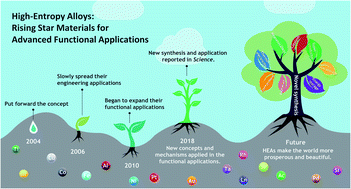High-entropy alloys: emerging materials for advanced functional applications
Abstract
Accompanied by enhancements in the ability to fabricate materials for humans, alloy-based materials have advanced from binary alloy systems to complicated compositions along with affording newer applications, which can accelerate the evolution of civilization. Recently, high-entropy alloys (HEAs) have drawn enormous attention in diverse fields because of their distinctive concept and unique properties. The impressive mechanical properties, such as excellent strength, unforgettable corrosion resistance, and superior thermostability, are inherited and overwhelming compared with traditional alloys. Therefore, HEAs have become an emerging class of advanced materials leading to a new field. Based on the exceptional synthesis methods, HEAs surprisingly afford numerous energy and environmental properties, which have endowed HEAs with promising applications. In this paper, we review the salient features of HEAs and summarize their core effects, phase structures, unconventional synthesis methods, and novel energy and environmental applications. In addition, we also discuss the broad space waiting to be explored and overview fruitful pathways of future trends and prospects.

- This article is part of the themed collections: Journal of Materials Chemistry A Recent Review Articles and Journal of Materials Chemistry A HOT Papers


 Please wait while we load your content...
Please wait while we load your content...